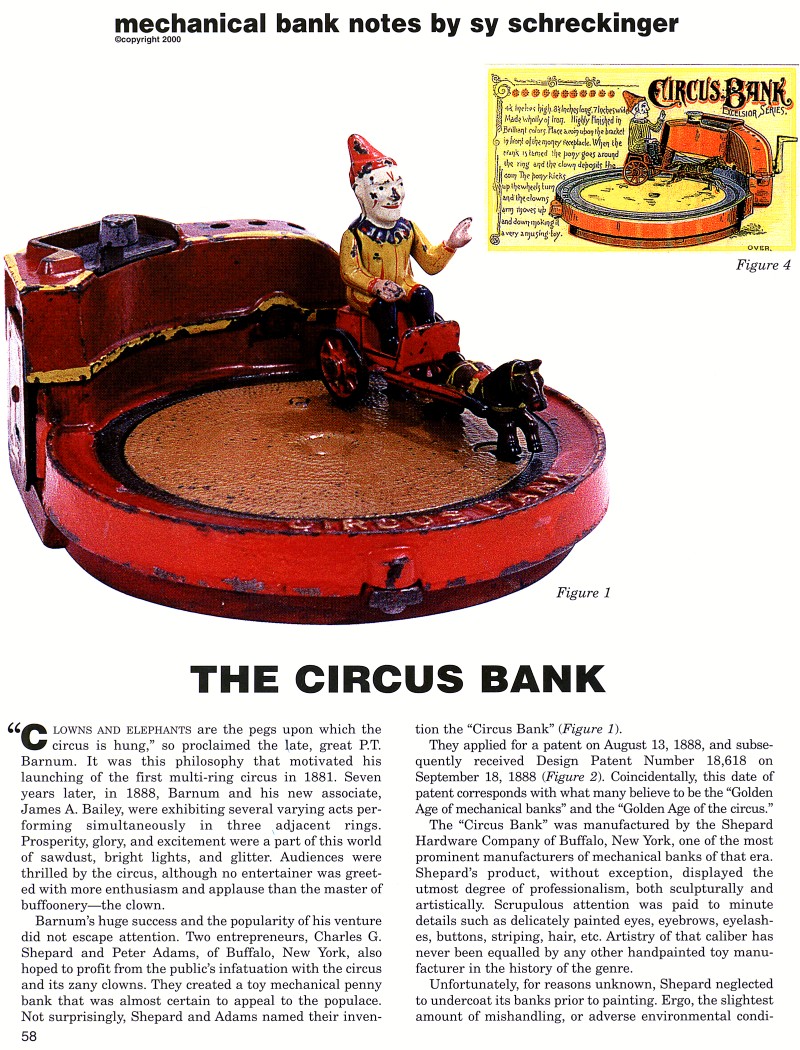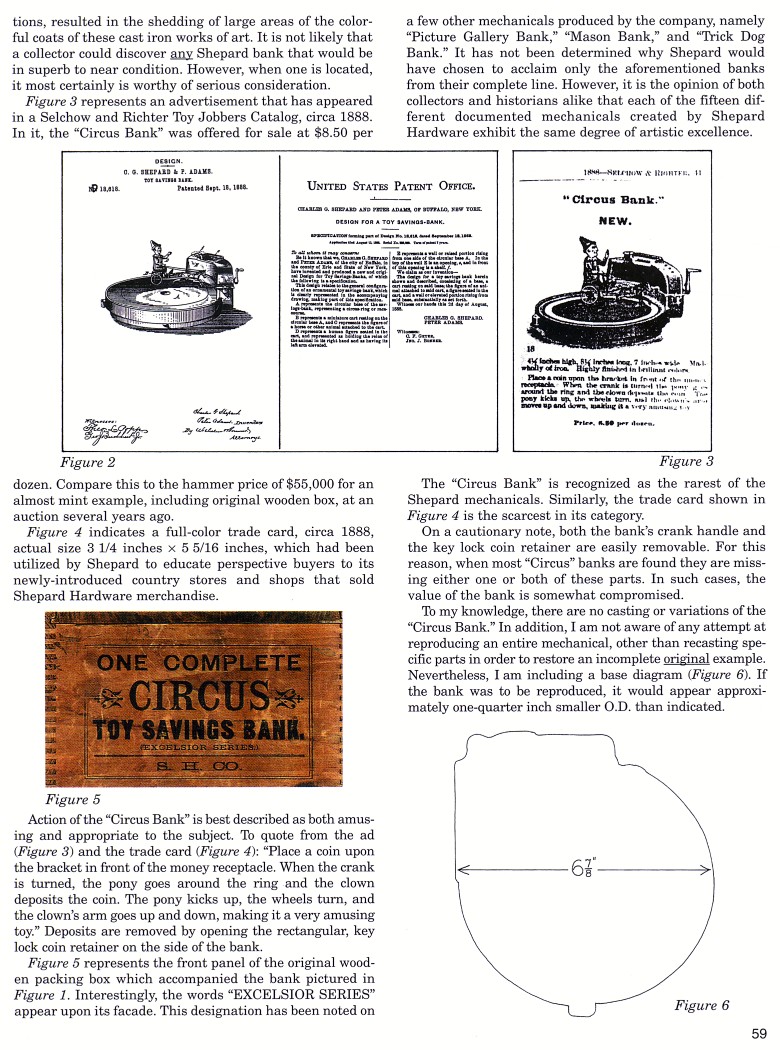|
The Circus Bank
by Sy Schreckinger – ANTIQUE TOY WORLD Magazine – June, 2000
Clowns and elephants are the pegs upon which the circus is hung,"
so proclaimed the late, great P.T. Barnum. It was this philosophy that
motivated his launching of the first multi-ring circus in 1881. Seven
years later, in 1888, Barnum and his new associate, James A. Bailey, were
exhibiting several varying acts performing simultaneously in three
adjacent rings. Prosperity, glory, and excitement were a part of this
world of sawdust, bright lights, and glitter. Audiences were thrilled by
the circus, although no entertainer was greeted with more enthusiasm and
applause than the master of buffoonery — the clown.
Barnum's huge success and the popularity of his venture did not
escape attention. Two entrepreneurs, Charles G. Shepard and Peter Adams,
of Buffalo, New York, also hoped to profit from the public's infatuation
with the circus and its zany clowns. They created a toy mechanical penny
bank that was almost certain to appeal to the populace. Not surprisingly,
Shepard and Adams named their invention the "Circus Bank" (Figure 1).
They applied for a patent on August 13, 1888, and subsequently
received Design Patent Number
18,618 on September 18, 1888 (Figure 2).
Coincidentally, this date of patent corresponds with what many believe to
be the "Golden Age of mechanical banks" and the "Golden Age of the
circus."
The "Circus Bank" was manufactured by the Shepard Hardware Company of
Buffalo, New York, one of the most prominent manufacturers of mechanical
banks of that era. Shepard's product, without exception, displayed the
utmost degree of professionalism, both sculpturally and artistically.
Scrupulous attention was paid to minute details such as delicately painted
eyes, eyebrows, eyelashes, buttons, striping, hair, etc. Artistry of that
caliber has never been equaled by any other hand painted toy manufacturer
in the history of the genre.
Unfortunately, for reasons unknown, Shepard neglected to undercoat
its banks prior to painting. Ergo, the slightest amount of mishandling, or
adverse environmental conditions, resulted in the shedding of large areas
of the colorful coats of these cast iron works of art. It is not likely
that a collector could discover any Shepard bank that would be in superb
to near condition. However, when one is located, it most certainly is
worthy of serious consideration.
Figure 3 represents an advertisement that has appeared in a Selchow
and Richter Toy Jobbers Catalog, circa 1888. In it, the "Circus Bank" was
offered for sale at $8.50 per dozen. Compare this to the hammer price of
$55,000 for an almost mint example, including original wooden box, at an
auction several years ago.
Figure 4 indicates a full-color trade card, circa 1888, actual size
3-1/4 inches x 5-5/16 inches, which had been utilized by Shepard to
educate perspective buyers to its newly-introduced country stores and
shops that sold Shepard Hardware merchandise.
Action of the "Circus Bank" is best described as both amusing and
appropriate to the subject. To quote from the ad (Figure 3) and the trade
card (Figure 4): "Place a coin upon the bracket in front of the money
receptacle. When the crank is turned, the pony goes around the ring and
the clown deposits the coin. The pony kicks up, the wheels turn, and the
clown's arm goes up and down, making it a very amusing toy." Deposits are
removed by opening the rectangular, key lock coin retainer on the side of
the bank.
Figure 5 represents the front panel of the original wooden packing
box which accompanied the bank pictured in Figure 1. Interestingly, the
words "EXCELSIOR SERIES" appear upon its facade. This designation has been
noted on a few other mechanicals produced by the company, namely "Picture
Gallery Bank," "Mason Bank," and "Trick Dog Bank." It has not been
determined why Shepard would have chosen to acclaim only the
aforementioned banks from their complete line. However, it is the opinion
of both collectors and historians alike that each of the fifteen different
documented mechanicals created by Shepard Hardware exhibit the same degree
of artistic excellence.
The "Circus Bank" is recognized as the rarest of the Shepard
mechanicals. Similarly, the trade card shown in Figure 4 is the scarcest
in its category.
On a cautionary note, both the bank's crank handle and the key lock
coin retainer are easily removable. For this reason, when most "Circus"
banks are found they are missing either one or both of these parts. In
such cases, the value of the bank is somewhat compromised.
To my knowledge, there are no casting or variations of the "Circus
Bank." In addition, I am not aware of any attempt at reproducing an entire
mechanical, other than recasting specific parts in order to restore an
incomplete original example. Nevertheless, I am including a base diagram
(Figure 6). If the bank was to be reproduced, it would appear
approximately one-quarter inch smaller O.D. than indicated.
|


